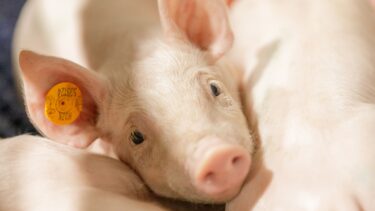Stimulating the digestibility of the piglet feed by optimising fat sources
Sow milk is, apart from water, mainly composed out of lipids, proteins & lactose. Sow milk, except colostrum, contains about 40% fat on a dry matter basis (see Figure 1) . So fat is a very important energy source for piglets under the sow which makes them capable to digest fat from sow milk in an efficient way (≈ 95%). To make the transition from sow milk to solid feed smoother, fat continues to be an important component in weaning feed as well. For maximum promotion of the piglet performance, it is therefore important to make the fat not only very tasteful but also easily digestible for piglets. This because, without good digestibility, high fat contents will cause a reduced feed intake and indirect also a higher risk on intestinal problems.

Fat digestion
After intake of the feed, the fat goes, through the stomach, to the small intestine. Before this non-polar fat can be absorbed by the aqueous, polar contents of the small intestine, it first needs to be emulsified. This natural emulsification is done by bile salts which are produced by the liver and secreted into the small intestine. Bile salts consist of bile acid conjugated with glycine or taurine and will divide the fat into smaller particles, increasing the total contact surface for digestive enzymes (see Figure).
In the second step, the fat particles (triglycerides) are broken down into monoglycerides and free fatty acids by the enzyme lipase, produced by the pancreas. After this, the different fat components are surrounded by bile salts and monoglycerides to form micelles. The content of these micelles can be absorbed by the microvilli in the small intestine.
The efficiency of this fat digestion depends on various factors: the fatty acid composition, the quality of the fat sources, and the age of the animal.

Factors affecting the digestibility
Fatty acid composition
There is a clear effect on the fat digestibility by piglets depending on the fat source used (see Table). Moreover, this effect is greater as the animals are younger. The efficiency of fat digestion is affected by 2 things: the chain length of the fatty acids and the unsaturated/saturated fatty acid ratio. Short and medium chain fatty acids are much more easily digestible and absorbable than long chain fatty acids. Coconut fat, for example, contains a high extent of medium chain fatty acids. Therefore, especially in young piglets, coconut fat is clearly more easily digestible than other fat sources. Unsaturated fatty acids are also digested more easily, since they can more easily be converted into micelles than saturated fats. Therefore, it is advised to add soya bean oil instead of animal fat in weaning diets despite the latter is more palatable.
| Weeks after weaning | 1 | 2 | 3 | 4 |
| Animal fat | 70 | 74 | 82 | 84 |
| Coconut fat | 82 | 81 | 90 | 90 |
| Soy oil | 73 | 79 | 89 | 89 |
Fat quality
A fat with a large proportion of free fatty acids in the feed is less digestible, since more bile salts are needed to incorporate free fatty acids in micelles compared to monoglycerides. Oxidised fat also has a negative effect on digestibility. Therefore a good fat contains less than 5-10% free fatty acids, contains few radicals and is preserved from rancidity. It is therefore advisable to analyse fat on rancidity parameters such as peroxide content, free fatty acids, p anisidine value, …
Age of the animal
At the time of weaning, the gastrointestinal system of piglets is not fully developed yet. At that moment, the level of bile salt production is very low. Therefore the bile salts are insufficiently present to emulsify the supplied fat and convert it into micelles. As a result, not all fat is digested in the small intestine. Particularly in piglets that were weaned young, the level of fat digestion is still low (Table).
Conclusion
Fat provides a substantial part of the available energy in piglet feed, and it is therefore important to make the fat digestion as optimal as possible. For this purpose, Earlyfeed uses coconut fat in the Babi prestarters and Vitastart concentrates, which is clearly more easily digestible in young piglets than other fat sources. This allows the piglets to achieve their full growth potential in an economic manner, while the intestinal health of the animals is secured.
Ezt a kapcsolatot az Ön által böngészett hely alapján javasoltuk. Természetesen más elérhetőségeinket és helyszíneinket is megtekintheti itt.

